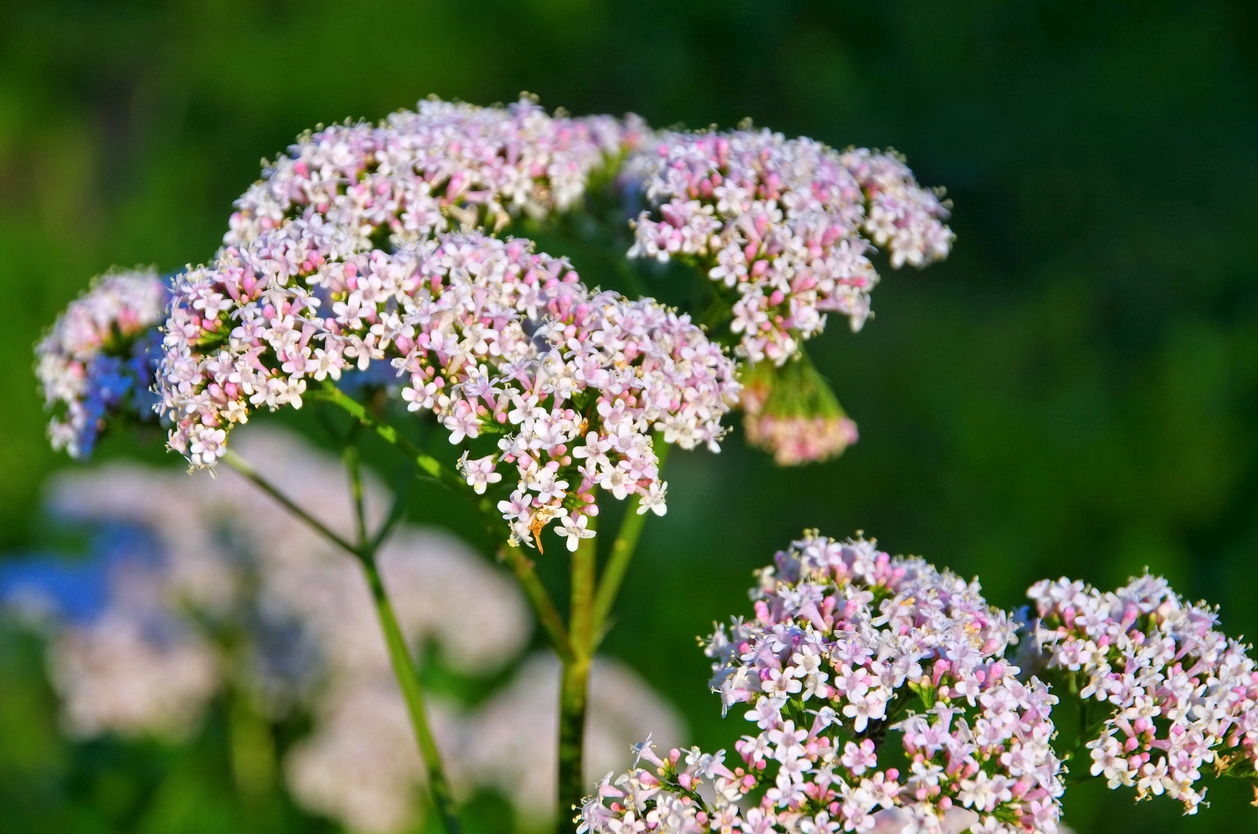More Images
A collection of some great images. Edit
Read More
Valeriana officinalis is a member of the Caprifoliaceae family and known for its general calming effects. Valerian has pleasant, sweet smelling flowers and pungently aromatic roots. Despite the strong odor, valerian root has been used since the times of ancient Greece and in traditional European folk practices. Commonly infused as valerian tea, the roots can also be mixed into herbal tea blends or tinctured.
Valerian is an erect perennial, growing to four feet with pinnate, divided leaves and clusters of small white or pink flowers. It has a massive root system and short rhizomes. The roots are a hairy, spindly mass and are collected in the autumn from two-year-old plants. Native to Europe and parts of Asia, it grows in meadows and woodlands within moist, temperate climates and has since been naturalized in North America. The plant grows up to two meters high and produces small clusters of white or pink flowers. The flowers have a sweet, pleasant scent, in distinct contrast to the roots of the plant. The root system consists of a vertical rhizome and an abundance of smaller rootlets.
Valerian will grow in most soil types and textures as long as there is good drainage, but it prefers a sandy loam. It tends to grow wild in grasslands and meadows. Providing your valerian plant gets sufficient moisture, they are a fairly hardy species that can survive in a variety of temperatures. Valerian is very cold hardy and will survive harsh winter conditions. The plants die back in winter and emerge again in spring.
The best times to harvest the roots of your valerian plant is either in spring or fall as that’s when the beneficial compounds are at their peak. After harvesting the roots, wash them well and then spread or hang them to dry in a warm place.
The Greek physicians, Galen and Dioscorides, aptly called the plant “phu” because of its distinctive and rather unpleasant smell resembling that of ancient leather or something akin to stale perspiration. The older botanical classification, V. phu, reflects this. The root is still added as a musky tone to perfumes.
The plant was named in the 9th or 10th century, and the name is thought to have derived from the Latin verb valere meaning “to be happy.”
Valium, the most widely prescribed antianxiety drug, is said to have taken its name from the same source and from the herb itself.
For centuries, it was used for a variety of disorders, including epilepsy, which, in 1592, a cure of such was published by Fabius Calumna. Today, there is some evidence to support it as an anticonvulsant.
First mentioned in a medicinal context by Isaac Judaeus in the year 924 CE, it has since been highly regarded by herbalists as a nervine and sedative. Dioscorides and Gerard taught that it was an antidote for poisons, but it is as a treatment for nervous complaints that Valerian has become most noteworthy.
Since cats and dogs are attracted to the scent, it is said that the Pied Piper of Hamelin carried the root to lure the rats, and his music was just a decoy. In cats, it acts as a stimulant and can be substituted for catnip. In humans, it has the opposite effect and is a very popular remedy for insomnia.
It has long been valued by Nordic, Persian, and Chinese herbalists.
The variety, V. sylvatica, was used by Canadian Indian warriors as a wound antiseptic.
Valerian was used during the First and Second World Wars for treating shell shock and nervous stress.
Many tribes used the herb for treating nervous conditions and insomnia. The Blackfoot also used it to treat stomach problems, while several tribes, including the Thompsons of British Columbia and the Menominee, have used valerian root topically to treat cuts and wounds.
Valerian’s healing properties have been recorded since the days of Galen and Hippocrates. Herbalist Nicolas Culpeper recommended it as a preventive for the plague in the 17th century. The root has been used for curing insomnia, coughs, menstrual cramps, and muscular pain, and the leaves are used for making a poultice for bruises.
Today most people use it to help promote sleep or relaxation. It can be made into a tea or infusion or taken in capsule form. Some prefer capsules because the tea has a pungent odor and astringent taste that can be unpleasant. Many people swear by valerian as a sleep and relaxation aid.
It has a relaxing nature is a benefit to those unable to relax during stress-related periods and in general has a more calming effect rather than a sedating one. It is also beneficial in relaxing over-contracted muscles and helpful for shoulder and neck tensions, asthma, colic, and irritable bowel syndrome.
It encourages ulcer and wound healing and, when used topically, is effective for muscle spasms and menstrual cramps.
As an expectorant, it helps a tickling, nervous cough.
A collection of some great images. Edit
Read MoreAngelica root is a staple among many wiccan herbalists. What do you think of this one? Edit
Read MoreAngelica is a plant. The root, seed, leaf, and fruit are used to make medicine. Angelica is used for heartburn (dyspepsia), intestinal gas (flatulence), loss of appetite (anorexia), overnight urination (nocturia), arthritis, stroke, dementia, circulation problems, "runny nose" (respiratory catarrh), nervousness and anxiety, fever, plague, and trouble sleeping (insomnia). Some women use angelica to start their menstrual...
Read MorePermaculturist and avid medicinal herb farmer Michael Pilarski "Skeeter" talks about Angelica (Angelica archangelica) roots! Filmed in Chimacum, Washington. Dec 6, 2018
Read More